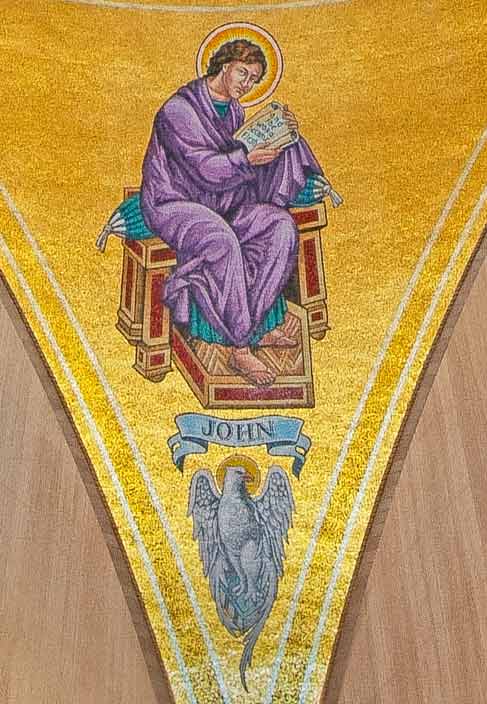
Known as the disciple “whom Jesus loved,” St. John the Apostle was not only one of Jesus’ closest friends, but a spiritual teacher for the ages. He is the author of a Gospel account, three epistles, and the book of Revelation. As we celebrate the feast of St. John, Apostle and Evangelist, this week, we invite you to explore these six facts about his life and legacy.

1. John first met Jesus when he was fishing with his brother James on the Sea of Galilee.
After an entire night of fruitless efforts, they were dubious when Jesus told them to lower their nets into the water once more. Yet they complied and caught more fish than they could keep in their boat (Luke 5:1-11). After this miracle, Jesus asked them to follow him, saying he would make them fishers of men (Matthew 4:18-22). Immediately, they cast aside their nets to follow him, and did not look back. What is striking about this account is that there was no hesitation on their part. James and John’s response to the call to follow Christ was immediate, unquestioning, and complete.
2. John is known as the disciple “whom Jesus loved.” (John 13:23)
John was one of Jesus’ closest disciples and was present for some of the critical moments of Jesus’ time on earth – witnessing the Transfiguration and the raising of Jairus’ daughter, and accompanying Jesus the night before His crucifixion in the garden of Gethsemane. He was also the only disciple to be present at Jesus’ crucifixion. During the Last Supper, John is described as having his head resting on Jesus, in a posture customary of the Eastern dining tradition and indicative of their close friendship.
3. John and his brother James were the only people to receive nicknames from Jesus.

John and his brother James‘ fiery evangelical zeal and extreme reactions inspired Jesus to – rather humorously – dub them “the Sons of Thunder” (Mark 3:17). When James and John heard a man casting out devils in Jesus’ name, they forbade him from doing it (Luke 9:49). Later in that same chapter, when Jesus set out for Jerusalem and the Samaritans refused to receive him on his journey, James and John were incensed. “Lord, do you want us to call down fire from heaven to consume them?” they asked. In both instances, Jesus rebuked them for their extreme reactions and unnecessary hostility.
4. Throughout his Gospel account and epistles, John emphasizes the significance of love.
In John’s telling of the Last Supper, Jesus’ final lesson centers on love:
“As the Father loves me, so I also love you. Remain in my love. If you keep my commandments, you will remain in my love, just as I have kept my Father’s commandments and remain in his love. I have told you this so that my joy may be in you and your joy may be complete. This is my commandment: love one another as I love you.” – John 15:9-12
5. John’s Gospel includes numerous minor details that are not seen in other Gospel accounts.
For instance, he gives the names of minor characters like the high priest’s father-in-law and the slave whose ear was severed at Jesus’ betrayal (John 18:13; 18:10). John’s Gospel also stresses the role of the Holy Spirit, mentioning that the Holy Spirit is promised by Jesus (7:37-39; 14:16-17), shows truth (16:13), and enables believers to continue the work of Jesus (14:16), among other things.
John’s Gospel is also unique because John’s principal purpose is to account for Jesus’ divinity, beginning with, “In the beginning was the Word, and the Word was with God, and the Word was God.”

6. John was the only disciple to pass away peacefully rather than in martyrdom.
His zeal for evangelism and heart of love continue to inspire the faithful and strengthen the devotion of believers throughout generations.
Saint John is portrayed in the Basilica in the following locations: the east buttress of the South Entrance; the Mary Memorial Altar; the St. John Chapel; the St. Joseph Chapel lunette window; the Our Mother of Africa Chapel; the Byzantine Ruthenian Chapel; the Our Lady of Czestochowa Chapel; “The Second Coming” mosaic; the west chancel clerestory window; the Triumph of the Lamb Dome mosaic; the Redemption Dome mosaic; and the Trinity Dome southeast pendentive.
Sources:
Butler’s Lives of the Saints (ed. by Bernard Bangley)
Cowan’s The Way of Saints

